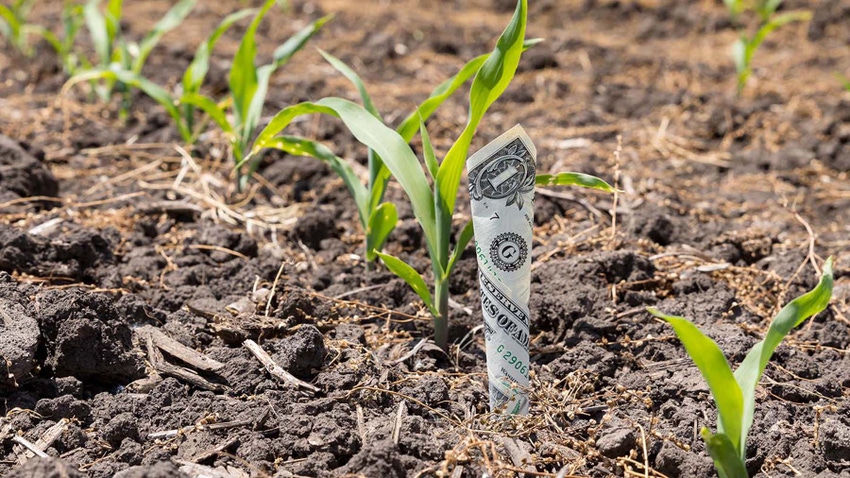
USDA’s Chief Economist Seth Meyer kicked off USDA’s 99th annual Agricultural Outlook Forum two-day session this morning with a macro-look at what might be in store for farmers in the markets in the 2023/24 marketing year. Prices are expected to dip from 2022/23’s highs but will still remain profitable as tight supplies in top global exporting countries remain tight.
Note: For brevity, I’ve compiled acreage results and economic analysis in another article. But this is the context in which those acreage, production, and usage decisions were made, so I thought it was important to highlight both conversations.
The Ukrainian war continues to be a driving factor in the markets, pushing more wheat acres into production in the U.S. in the upcoming marketing year. Consecutive years of crop shortfalls around the world and ongoing COVID-related issues have helped exacerbate price volatility.
“While it turned out to be a good year in 2022, it wasn't without some stress,” Meyer noted, citing numerous global and macroeconomic factors that will influence 2023 acreage allocations, production prospects, and usage forecasts.
Global forces at play
Ukrainian grain exports are slowing ahead of the hopeful renewal of the Black Sea Grains Initiative in March. “That moderates global grain prices, whether that grain ends up in a specific country or not, availability in the world market reduces wheat prices and other commodity prices,” Meyer explained.
But even with the BSGI in place, the market incentives to boost Ukrainian production aren’t enough to convince Ukrainian farmers to return to pre-war acreage plans amidst the ongoing Russian invasion. WAOB expects Ukrainian farmers planted fewer winter wheat acres last fall and will be hard-pressed to expand corn acres this spring.
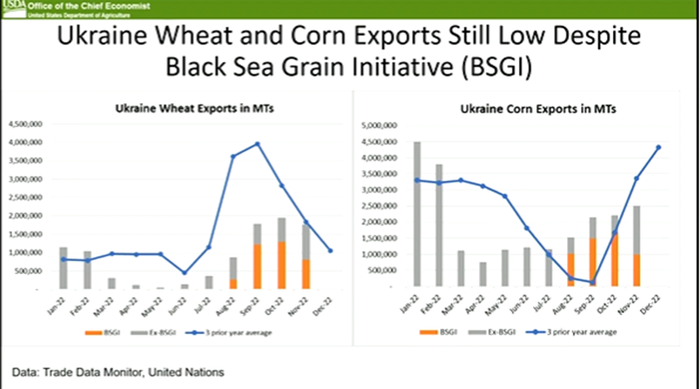
Meanwhile, Brazil’s safrinha (second crop) corn planting is behind schedule. Brazilian farmers are still within the optimal window for corn yields, but it will largely depend on how rains fall I the South American country over the coming weeks.
“If the rain stops on time, it's a decent crop.If it stops early, it's a bad crop.If they get extended rains, they get good yields,” Meyer explained. “A couple weeks can matter in terms of when that critical point of development comes in their rain cycle. This is a crop, which will be made as American farmers are going into the field to plant their corn and will be marketed in the couple months before they market their own crop.”
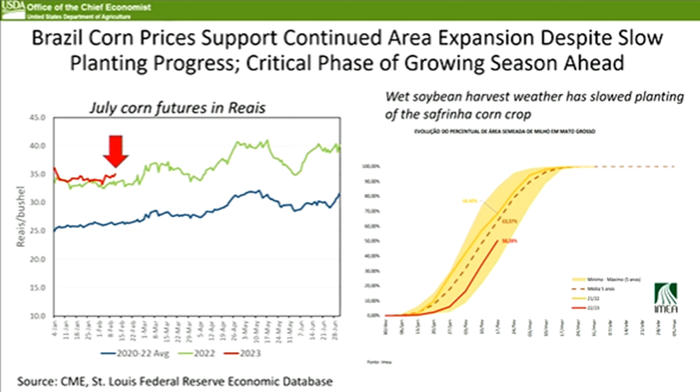
Brazil’s record-setting soybean harvest is expected to offset anticipated crop losses in Argentina due to drought. While Brazil’s behemoth crop takes center stage on the international market, U.S. farmers still have some reasons to keep planting soybean acres in 2023.
Domestic opportunities and challenges
Soy crush margins in the U.S. are highly profitable right now, encouraging more domestic consumption of soybeans. More domestic production could help keep prices in the U.S. high in the 2023/24 marketing year. Meyer shared that WAOB is expecting a 25% increase in crush capacity over the next several years for soyoil used in renewable diesel production as more capacity comes online.
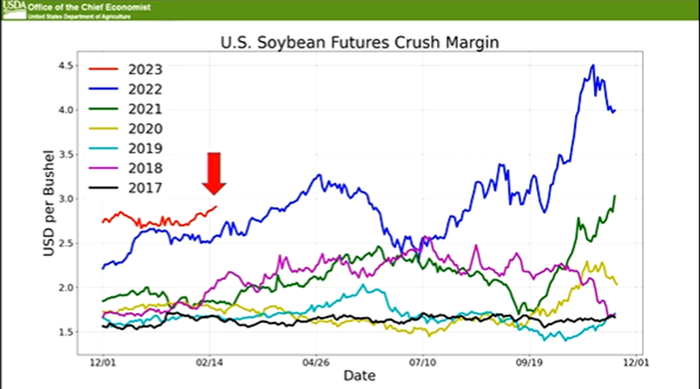
U.S. ag exports set new record highs during the 2022 calendar year. But a combination of lower export volumes and shrinking commodity prices amid a stronger dollar means that those highs will not likely be reset in 2023. Last year’s exports rose to $196 billion, but 2023 revenues are forecast nearly 6% lower at $184.5 billion.
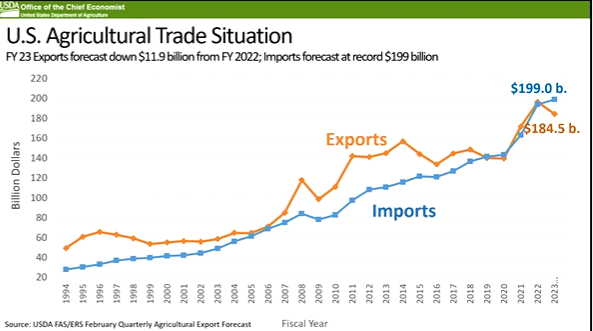
Even with the lower estimate, ag export revenues in 2023 are expected to be the second largest on record, providing valuable profit opportunities to U.S. farmers in the coming months. China will once again be the top buyer of U.S. ag products this year, though its sales likely won’t match last year’s receipts. Mexico and Canada will closely jockey for second and third place.
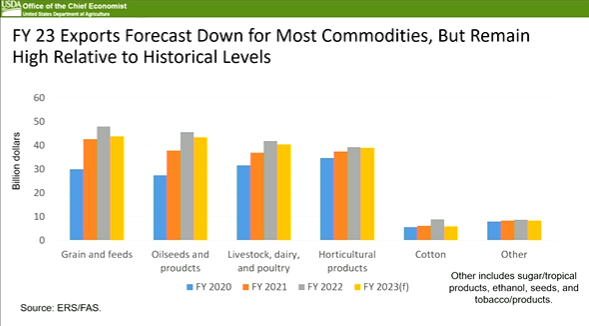
Cattle markets remain in a long contraction cycle as Western drought and high feed prices prevent herd expansion activity in key cattle-producing areas. The continuation (or hopeful end) of the drought will be the major determinant if herd expansion will begin in 2025-2026.
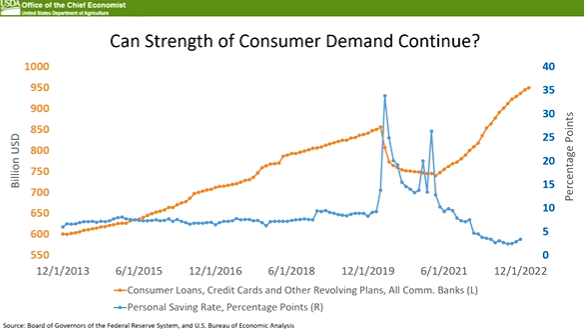
Broiler and hog production will increase this year, sending those prices lower. But the cattle herd shrink is so large that it is offsetting gains in broilers and hogs in terms of total meat production.
Strong consumer meat demand and the shrinking herd size will keep cattle prices high in 2023. But there are growing doubts that consumers will continue that trend if a recession hits the U.S. economy this year.
Profitability projections
Food price inflation is beginning to ease and input costs, like fuel and fertilizer, are slowing their rise after surging in 2022. Growth in land rents is also slowing. So while revenues may be forecasted lower this year, there is still a favorable chance farmers will remain profitable, even if 2022’s record net farm income (nominal) is not matched.
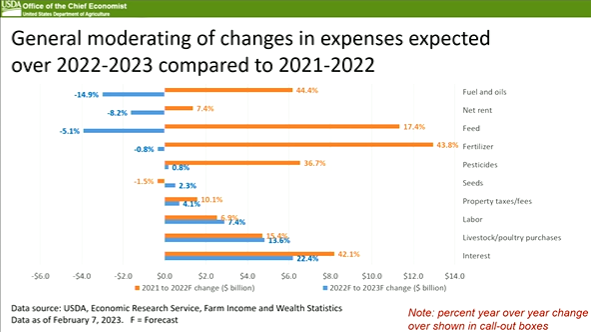
“We saw some pressure underlying what was a good year in 2022 and folks may be thinking, hey, 2022 was not sustainable, in terms of overall farm income, it was a record high year to some extent, and so, you're going to pull back from that a little bit. An expectation that, perhaps, input prices will stop rising as commodity prices begin to fall,” Meyer forecasted.
Earlier this month, USDA’s Economic Research Service forecasted that 2023 net farm income would fall 16% below year ago values. However, the farm economy is expected to remain strong in 2023 as this year’s earnings are expected to be the 15th largest on record after inflation adjustments.
“Commodity price is falling, input price is rising, but slower, government payments pulling back from pandemic payments and yet, we end up with farm income number above average for the last couple decades. So, is it as good as 2022? No, but the expectation is it will still be an above average year.”
Learn more about USDA's acreage, production and usage projections: USDA expects U.S. grain harvest increase in 2023
About the Author(s)
You May Also Like






